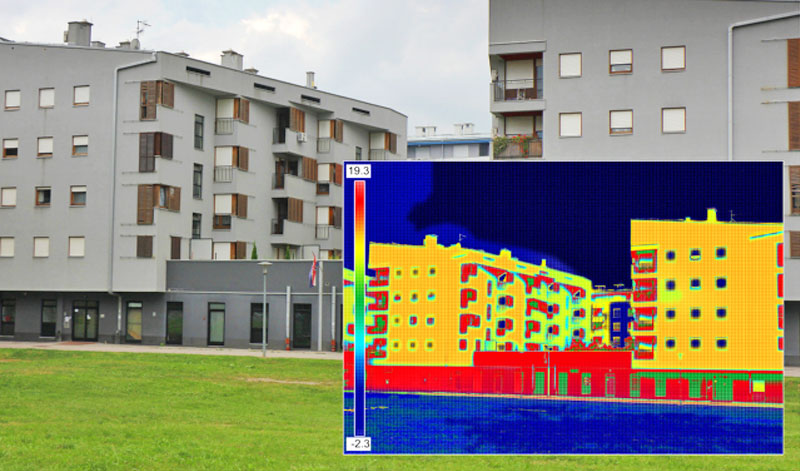
Performance Testing Pushes the Building Envelope
Your building envelope—walls, windows, doors and roof—is designed to bring in things you want, such as ventilated fresh air and daylight. It’s also your protection against unwanted air and water intrusion, as well as thermal leakage. How is your building envelope doing? Apply these three tests to assess your facility. It will give you the information you need to push your building envelope to another level in comfort and performance.
Clearing the air
Ventilation is the controlled intake of air into a building to maintain a healthy indoor environment. That’s good. Infiltration is uncontrolled air intrusion, which can waste energy and reduce comfort. Not so good.
Blower doors are used to test the susceptibility of a building to uncontrolled air intrusion. A temporary door with built-in fans replaces a normal door in an exterior doorway. The variable-speed fan blows air out of the building, resulting in lower indoor air pressure. Pressure gauges measure the air pressure inside the building and determine the amount of airflow out of the building. The amount of airflow depends on the “tightness” of the building envelope. A leaky building with lots of air intrusion will result in a high airflow rate at a given indoor pressure.
Guidelines for performing the test are covered in ASTM E779 – 10 Standard Test Method for Determining Air Leakage Rate by Fan Pressurization. An indoor test pressure of 75 pascals equivalent to 0.3 inch of water simulates an external 25 mph wind speed. Various standards require the airflow at 75 pascals pressure to not exceed a certain cubic feet per minute for each square foot of building space (CFM75). The U.S. Army Corps of Engineers Air Leakage Test Protocol for Building Envelopes has a 0.25 CFM per square foot limit, while ASHRAE 90.1-2016 Energy Standard for Buildings specifies a maximum 0.40 CFM per square foot.
Because buildings are different, the calculated air changes per hour (ACH) can normalize building airtightness and allow for some comparison. For instance, if the enclosure (20,000 sq ft building) volume is 157,000 cubic feet and your CFM75 blower door test result is 1570 CFM, then your air changes per hour would be around 0.6. That is equivalent to 0.08 CFM per square foot.
Testing the waters
Water intrusion testing is typically conducted by constructing a sealed chamber on the inside of the assembly being tested (walls, doors or windows). The air is then exhausted from that chamber to produce pressure differences similar to those produced by weather. Water nozzles spray water onto the outer surface. ASTM E1105 – 15 Standard Test Method for Field Determination of Water Penetration of Installed Exterior Windows, Skylights, Doors, and Curtain Walls, by Uniform or Cyclic Static Air Pressure Difference establishes the test parameters. It determines the number of nozzles, their spacing and distance to the building envelope surface, and the water pressure and volume. Generally, the spray-rack system delivers water to the test assembly at a rate equivalent to 8 inches of rain per hour. Zero intrusion is the goal.
Catching the heat wave
Infrared thermography captures infrared radiation emitted from the building envelope surfaces and displays these invisible wavelengths as visible light images. Temperature differences can identify improperly installed or damaged insulation, locate costly air leakage, and evaluate the overall thermal performance of buildings. ASTM C1060 – 11a (2015) Standard Practice for Thermographic Inspection of Insulation Installations in Envelope Cavities of Frame Buildings establishes the test criteria—the required spectral range, field of view, and minimum resolvable temperature difference (MRTD) for testing.
For more information and resources on how to improve the comfort and efficiency of your facility, see Building Envelope from the U.S. Department of Energy.